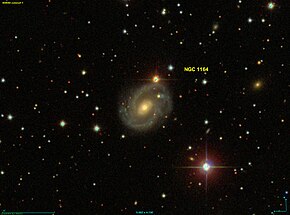NGC 1164
| NGC 1164 | |
|---|---|
 NGC 1164 (Hubble Space Telescope) | |
| Observation data (J2000.0 epoch) | |
| Constellation | Eridanus |
| Right ascension | 03h 02m 24.45s[1] |
| Declination | −11° 19′ 00.0″[1] |
| Redshift | 0.012846[1] |
| Heliocentric radial velocity | 3842 ± 23 km/s[1] |
| Distance | 60 Mly[1] |
| Apparent magnitude (V) | 12.50[1] |
| Apparent magnitude (B) | 13.00[1] |
| Characteristics | |
| Type | (R')SAB(rs)b[1] |
| Apparent size (V) | 1.5 x 1.3[1] |
| Other designations | |
| PGC 11275, MCG -02-08-030, UGC 2433 | |
NGC 1164 is a barred spiral galaxy located in the constellation Eridanus, approximately 60 million light-years from Earth. It was discovered by the astronomer John Herschel in 1834. NGC 1164 is classified as a (R')SAB(rs)b type spiral galaxy, with a prominent central bar structure and well-defined spiral arms.[2]
Structure and features
[edit]NGC 1164 is a relatively large galaxy, measuring roughly 100,000 light-years in diameter. It is characterized by its bright, central bulge and the elongated bar structure that spans its core. The galaxy's spiral arms are well-developed and feature areas of intense star formation.[3]
Observations of NGC 1164 using both optical and infrared telescopes have revealed a rich population of stars and gas clouds, indicating an active star-forming region within the galaxy. It also displays signs of a central supermassive black hole, a common feature in many large galaxies.
Location and distance
[edit]NGC 1164 is located in the southern constellation Eridanus, which is visible from Earth's southern hemisphere. It lies at a distance of approximately 60 million light-years from the Milky Way, making it part of the larger structure of galaxies in the local universe.
Observational history
[edit]John Herschel discovered NGC 1164 in 1834 while observing the southern skies. Since its discovery, it has been a subject of interest for both amateur and professional astronomers, especially due to its relatively well-preserved spiral structure and central bar.
It has been studied in various wavelengths of light, including optical, infrared, and radio, contributing valuable insights into the mechanisms of star formation and galactic dynamics. Modern observations, including those by the Hubble Space Telescope, have helped to create detailed images of the galaxy.
Significance in astronomy
[edit]NGC 1164 is part of the catalog of galaxies known as the New General Catalogue (NGC), a collection of astronomical objects compiled in the 19th century. As a barred spiral galaxy, NGC 1164 is an important example of this type of galaxy, allowing astronomers to study the structure, dynamics, and evolution of barred spirals in greater detail.
Research on galaxies like NGC 1164 helps to improve our understanding of galactic formation, the role of central black holes, and the processes that drive star formation in different regions of the universe.
Supernovae
[edit]Two supernovae have been observed in NGC 1164:
- SN 1993ab (type Ia, mag. 18) was discovered by Jean Mueller on 24 September 1993.[4][5]
- SN 2016hsr (type II, mag. 18.5) was discovered by the Lick Observatory Supernova Search (LOSS) on 2 November 2016.[6]
See also
[edit]References
[edit]- ^ a b c d e f g h i NASA/IPAC Extragalactic Database
- ^ "NGC 1164". NASA/IPAC Extragalactic Database. Retrieved 2024-12-22.
- ^ "NGC 1164". SIMBAD Astronomical Database. Retrieved 2024-12-22.
- ^ Mueller, J.; Mendenhall, J. D.; Djorgovski, S. G.; Smith, J.D. (1993). "Supernova 1993ab in NGC 1164". International Astronomical Union Circular (5871): 2. Bibcode:1993IAUC.5871....2M.
- ^ "SN 1993ab". Transient Name Server. IAU. Retrieved 22 December 2024.
- ^ "SN 2016hsr". Transient Name Server. IAU. Retrieved 22 December 2024.
